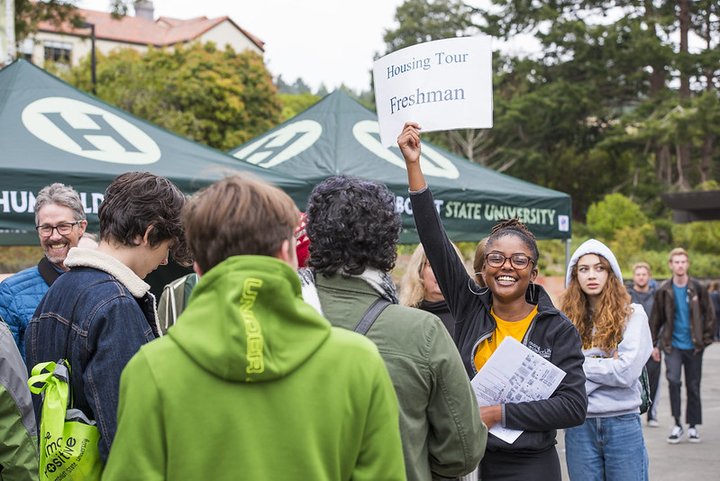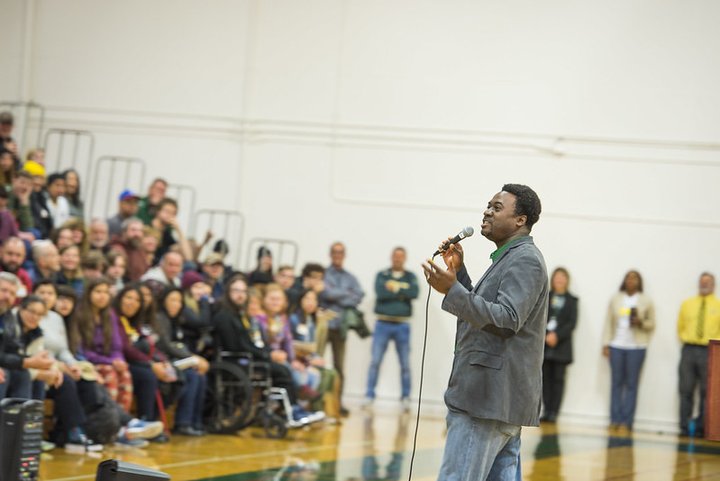
Photo courtesy of HSU’s Flick account
As you may have seen, Humboldt State is investing major dollars in scholarships for students from local high schools.
The $1,000 per year scholarship is called Humboldt First, and has been offered to around 430 local students from a number of local schools so far. Officials from Humboldt State have met with students from Eureka High School, Arcata High School, McKinleyville High School, students in Del Norte County and many others. HSU officials are also planning on having scholarship ceremonies out in Hoopa, Ferndale, Fortuna and at the Northcoast Preparatory Academy later this month and in early February.
“We are hitting all the North Coast schools in our service region,” Jason Meriwether, vice president of enrollment management for Humboldt State told the Outpost. “But we have to do the work to yield as many students as possible. Let’s say if we get 10 or 15 students from Eureka out of the 92 we offered. That is a huge win.”

Jason Meriwether
Meriwether is not new to higher education. He earned his Ph. D in education administration from Indiana State University, or as he put it, “the house that Larry Bird built.” He previously worked at a number of universities where he taught graduate level courses and served as an administrative official — such as at Fisk University where he served as the vice president of student engagement and enrollment management.
Meriwether said that once he first arrived to Humboldt in the summer of 2019, he, along with President Tom Jackson and Director of Admissions Pedro Martinez, immediately started to get out in the community to chat with representatives from the local schools in order to get a feel of things.
“It became clear very quickly, that we had to work very hard to re-engage our local community,” Meriwether said. “We read data that showed enrollment trends for the last five to ten years and [saw] we had a significant gap that we had to fill. There was a significant need for the current Humboldt State administration to really engage and get out there in the local community and invest.”
And so the idea for the Humboldt First scholarship started to take root. The funds for the scholarships total around $250,000, which are provided by donors and the Humboldt State University Foundation, a group that “provides expertise, fiduciary oversight, and advocacy to increase charitable giving and manage the endowment and other charitable funds.” Meriwether said he was really grateful the Foundation was willing to get the money together to support local students.
“When we made the ask, the Foundation was very willing to support, [they] really loved the idea and have been very easy to work with.” Meriwether said. “They had no hesitation in putting the money toward what we wanted to do.”
When asked why this wasn’t implemented before, Meriwether said he couldn’t speak for past administrations, only for the current one.
“The best way to answer that is to say that this is the approach the current administration is taking to utilize resources,” he said. “I can’t answer why it didn’t happen before. I think the opportunity was there.”
When asked if HSU is shifting resources from recruiting outside of the area to focus more on the local population, Meriwether said HSU has to do both.
“From a scholarship standpoint we have invested in our local students and I think that makes a huge statement to the North Coast area that we are committed to having more local students attend Humboldt State,” Meriwether said. But he also noted that this will be in conjunction with recruiting efforts for students from outside of the area.

Photo courtesy of HSU’s Flick account
The Humboldt First Scholarship is only one part of a multi-faceted approach to increase enrollment at HSU. As part of the strategy to increase enrollment, Meriwether said they broke California up into five regions and pulled data to help understand which areas are funneling the most students into HSU. From this, they have been able to identify the top ten high schools and community colleges that feed the most students.
Meriwether mentioned that there is one community college that has routinely around 200 applicants a year, but HSU only ends up enrolling 10 or 12 of them.
“So that is a place where we would say, ‘Okay, what do we have to do to be present?’ We have to send more faculty to recruit, have more follow-ups, use more social media and digital targeting, be really aggressive in our presence there, but more strategic to get the yield up,” Meriwether said.
He went on to say that HSU wants to focus on schools that used to send a lot of students to HSU but have been neglected over the past few years by rebuilding relationships with counselors and principals, and by building a presence in those areas.
The current student enrollment at HSU is down by nearly 1,000 students compared to last year, and those numbers are expected to continue to decline. However, Meriwether is working to fight those projections.
“You’re not going to write a story this fall that says ‘Hallelujah, Humboldt has turned it around.’ I wish you could,” Meriwether said. “But I think that maybe by Fall 2021 or Fall 2022, I think that the ‘Humboldt enrollment decline’ story should be put to bed.”

Meriwether addressing HSU students
There is also a need to focus on retention at Humboldt State as well. According to internal reports from 2018, HSU had four-year graduation rate for first-time freshmen of 21.9 percent. The six-year graduation rate for first-time freshmen was 51.8 percent in 2018 and the two-year graduation rate for transfer students was 37.8 percent. Meriwether said increasing the overall student experience will help these numbers improve. One way they are improving this is by spending money, about $50,000, on programming for the cultural centers on campus.
“Our Foundation has been so great to work with and all we had to do was make the ask and have the strategy,” Meriwether said. “To your earlier question about why that hasn’t done in the past, I don’t know. But I can tell you we are doing it now.”
CLICK TO MANAGE